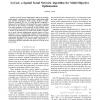Free Online Productivity Tools
i2Speak
i2Symbol
i2OCR
iTex2Img
iWeb2Print
iWeb2Shot
i2Type
iPdf2Split
iPdf2Merge
i2Bopomofo
i2Arabic
i2Style
i2Image
i2PDF
iLatex2Rtf
Sci2ools
CEC
2009
IEEE
2009
IEEE
LoCost: A spatial social network algorithm for multi-objective optimisation
—Particle Swarm Optimisation (PSO) is increasingly being applied to optimisation of problems in engineering design and scientific investigation. While readily adapted to singleobjective problems, its use on multi-objective problems is hampered by the difficulty of finding effective means of guiding the swarm in the presence of multiple, competing objectives. This paper suggests a novel approach to this problem, based on an extension of the concepts of spatial social networks using a model of the behaviour of locusts and crickets. Comparison is made between neighbouring particles based on Pareto dominance, and a corresponding repulsion between particles added to previously suggested attractive forces. Computational experiments demonstrate that the new, spatial, social network optimisation algorithm can provide results comparable to a conventional MOPSO algorithm, and improved coverage of the Pareto-front.
| Added | 21 Jul 2010 |
| Updated | 21 Jul 2010 |
| Type | Conference |
| Year | 2009 |
| Where | CEC |
| Authors | Andrew Lewis |
Comments (0)

